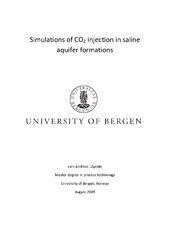| dc.description.abstract | This thesis is devoted to studies of long term storage of carbon dioxide in geological formations such as saline aquifers. The goal of the thesis is to contribute to the development of a totally integrated storage evaluation tool which considers reactive transport as well as geomechanics. Our secondary goal was to investigate the effects of introducing a fracture in the confining cap rock with respect to the mechanical and chemical aspects of gas injections. In order to safely assume that injected gas will not escape the geological formation, it is imperative to obtain knowledge about reservoirs and the dynamics connected carbon dioxide injections. Laboratory experiments can only provide limited knowledge and large scale projects are economically not feasible and will only produce results after several years. The best approach would be to develop and utilize reservoir simulators capable of predicting the chemical and mechanical behaviour. However such simulators need benchmarking and comparison with respect to injections in real reservoirs. There is no need to look further than our own continental shelf to find operational fields with pilot projects of CO2 injections. The SACS-project (Saline Aquifer Carbon dioxide storage) was initiated in 1996 at the Sleipner field and has been continuously monitored is a valuable source of data for simulation comparisons. The coupled codes calledknown as Retraso CodeBright (RCB) have been used to simulate the injection of CO2 in an aquifer. RCB originates from the Technical University of Catalonia, of which the team contributing with the two chemical and mechanical parts of the code consisted of Maarten W. Saaltink, Carlos Ayora and Sebastia Olivella. [RCB manual] The platform was initially intended for standard conditions at 1 atm pressure and 15 celcius. Reservoirs of interest to geological sequestration are generally at larger depths, which mean that the governing equations has to deal with higher pressures, temperature and stresses than originally intended. Despite of the intended application of the software, RCB was selected as a candidate for project Observing the effect of long term CO2 storage in saline aquifers" which is carried out in the Department of Physics and Technology at the University of Bergen, Norway. [art] As part of this project, and as initially intended, the RCB code has received a range of modification in order to apply on deep formation CO2 storage. The simulations were run with conditions similar to those found in the Utsira formation supplemented with data from simulations in the FLAC3D model. However, due to limited sources of relevant use and the original application of the code platform, I have spent some time learning how to apply the code on deep formation conditions. Most of my initial simulations diverged and it's only during the last 3 months that I have succeeded in producing presentable data. | en_US |
